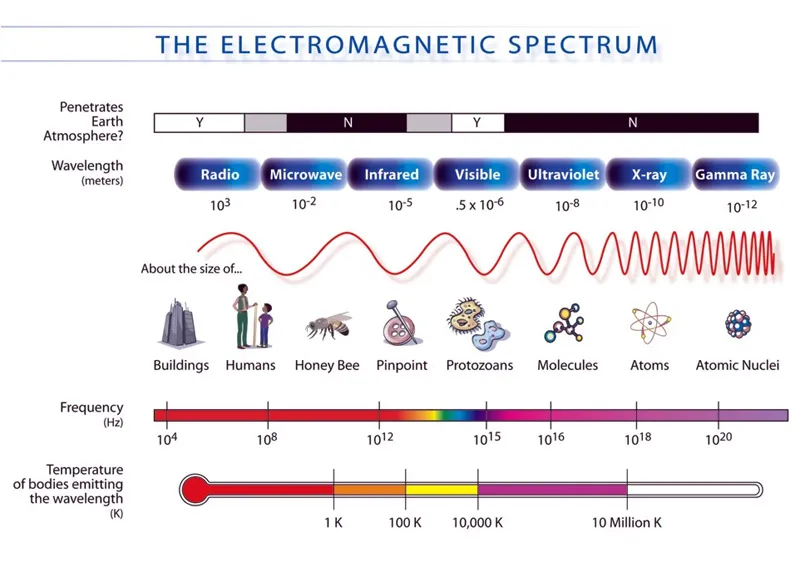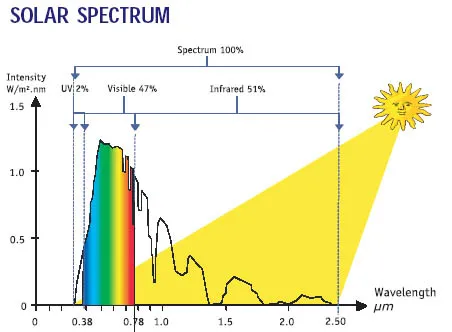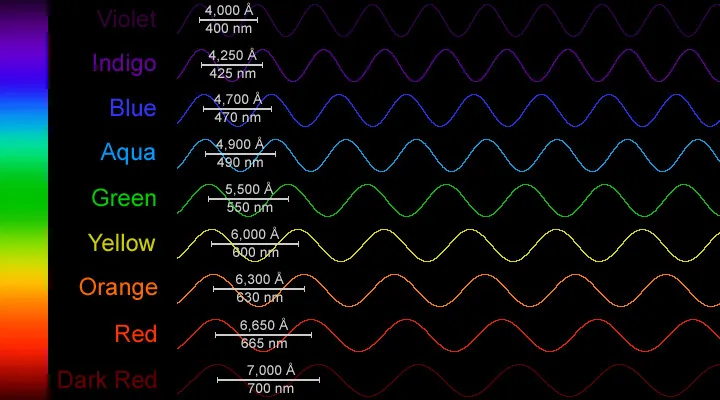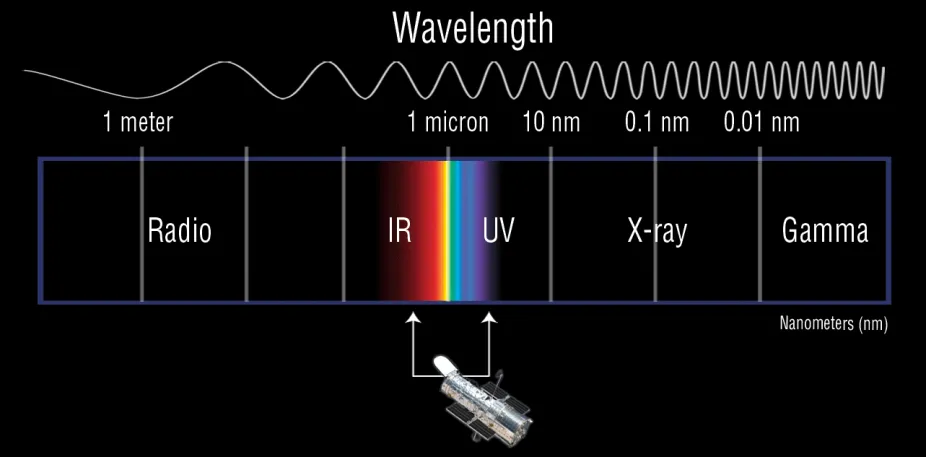Electromagnetic (EM) Spectrum
Electromagnetic radiation is energy that travels as particles or waves, spreading out as it goes. The majority of the electromagnetic radiation that affects the Earth comes from the Sun. We can understand this radiation by looking at its range of wavelengths and frequencies, from the longer wavelength, low-frequency radio waves, to shorter wavelength, high-frequency gamma waves. Together, all of these different energy types, most of them invisible, are called the electromagnetic (EM) spectrum, or spectrum for short.

The electromagnetic spectrum represents different energy types based on wavelength and frequency.
NASA
Different types of energy on the electromagnetic spectrum can be grouped by wavelength, which is usually measured in nanometers (10-9 meters, or one billionth of a meter) or angstroms (10-10 meters), where 1 angstrom is approximately the diameter of an atom. It’s difficult for us to even grasp how tiny some of these energy wavelengths are: the wavelengths associated with visible light (about 500 nm) are about the size of a protozoan, a single-celled organism. In comparison, a single sheet of paper is about 100,000 nm thick. The differences between wavelengths of electromagnetic energy are important for determining the radiation types reaching Earth.
The Solar Spectrum
Energy from the Sun reaches Earth as solar radiation, which composes just one part of the full electromagnetic spectrum. Solar radiation includes the visible light we see and many other “colors,” or wavelengths, of energy that are beyond the range of human vision.

Solar energy consists primarily of visible light that we see and infrared radiation that we can sometimes feel as heat.
Public domain
Visible light represents about 47% of the energy Earth receives from the Sun. Over half of the Sun’s energy reaches Earth as infrared energy, which is invisible but which we can sometimes experience similarly to heat. Ultraviolet (UV) radiation, which is also invisible, makes up about 2% of the solar spectrum.
Visible Light - The Part of the EM Spectrum that We See
Visible light makes up just a portion of the entire electromagnetic spectrum, from 380-700 nanometers.Our eyes most often perceive visible light from the Sun as white light, but in reality, it is made up of a rainbow of different colors of the spectrum. Each color in the visible part of the electromagnetic spectrum is a different wavelength of light - from longer red wavelengths to shorter blue and violet wavelengths. The visible part of the electromagnetic spectrum is often abbreviated ROYGBIV based on the first letters of each color’s name (red-orange-yellow-green- blue-indigo-violet).

The visible light region of the electromagnetic spectrum is made up of different-sized wavelengths of light. Each wavelength defines a unique color. All wavelengths of visible light together make up white light.
Windows to the Universe/Randy Russell
Blue isn’t the dominant wavelength in the visible part of the spectrum, but our sky appears blue on a clear day because Earth’s atmosphere scatters shorter, blue light wavelengths most effectively.
The Invisible Portions of the Electromagnetic Spectrum
Infrared radiation has wavelengths from 780 nm to 1,000,000 nm (or 1 mm), longer than those of visible light. We sometimes think of infrared radiation from the Sun as heat, but infrared radiation is not quite the same thing as heat. In fact, infrared radiation may not always feel warm. Even objects we consider being very cold, such as an ice cube, give off infrared energy.

Energy types on the electromagnetic spectrum are denoted by wavelength. Infrared wavelengths are longer than those of visible light, while ultraviolet wavelengths are shorter.
NASA
Ultraviolet radiation has shorter wavelengths than visible light, comprising the 100-400 nm part of the spectrum.
There are also other types of radiation that come from the Sun, such as X-rays, gamma rays, and radio waves, that are invisible to the human eye. Only small amounts of these more unusual types of radiation reach Earth due to the protective shielding of Earth’s magnetosphere.
Characteristics of the Electromagnetic Spectrum
Each section of the electromagnetic (EM) spectrum has characteristic energy levels, wavelengths, and frequencies.

The electromagnetic spectrum includes energy from long wavelengths (radio waves), through visible light, all the way to short-wavelength X-rays and gamma waves.
NASA
Radio waves, shown on the left side of the spectrum, have the lowest energies, longest wavelengths, and lowest frequencies of any type of radiation. Microwaves (like the ones used in microwave ovens) are shown just to the right of radio waves on the EM spectrum and have a little bit higher energy. Gamma rays, shown on the far right side, have the highest energies, the shortest wavelengths, and the highest frequencies. These higher-frequency radiation types are among the most dangerous to humans and can cause damage by penetrating the skin and harming cells.